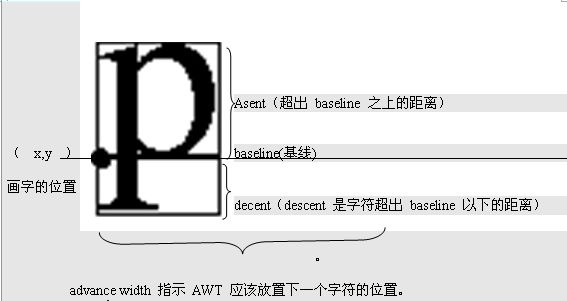Qt 字体大小的计算
Updated:
计算字符串或者字符宽度的系统函数有:
QLabel::fontMetrics().width(QString s): 获取字符串s的总像素宽度。
|
|
QLabel::fontMetrics().height(): 获取字体的高度。
int QFontMetrics::height () const
|
|
QLabel::fontMetrics().lineSpacing(): 获取字体的高度,包括文字的实际宽度和行距。
QLabel::fontMetrics().leading(): 行间距
|
|
QT内部计算字体、像素和字符宽度之间的方法是:
见地址:http://losemyheaven.blog.163.com/blog/static/17071980920111283934557/
在QFont当中有两种方式设置字体大小,一种是PixelSize,另一种是PointSize
Point实际是磅,也就是 1/72 inch
我们可以从PainterDevice中得到当前DPI(Dot per inch)。因此 Pixel = DPI * Point / 72
例如设置字体为20Point。 那么字体的像素大小是 90 * 20 / 72 约等于 25.
可以将字体设置为25Pixel,看到字体的大小就是20Point和25Pixel大小是一样的。
QFont当中设置的大小,实际上字体的高度,由如下组成。
由PixelSize设置的高度,实际是Asent + 1像素(baseline的高度)。
在字体大小中涉及了以下知识:
DPI: Dot per inch,在显示器上也就是每英寸包含的像素。英尺的换算为 1 cm = 0.39 inch, 1 inch = 2.54 cm。
DPI 可以通过如下计算得来:
|
|
大部分显示器的DPI为90.6左右,垂直和水平点距可能不一样。但windows为了方便就同一了点距,为96。我当前使用的Ubuntu的点距也是96。因此如果想要看到更大的字体可以使用更大的点距。
终于弄明白了 pixel size 是所占的像素大小 这样有一个缺点 有些显示器的分辨率(dpi)比较大 那么单位长度中的像素点就比较多 这样一个字所占的长度就会比较少
而 point size 则规定了实际中我们肉眼看到的字体的大小 他和pixel无关的~ 他和显示器无关 不管在什么样上的显示器上 规定大小是多少>就是多少…

